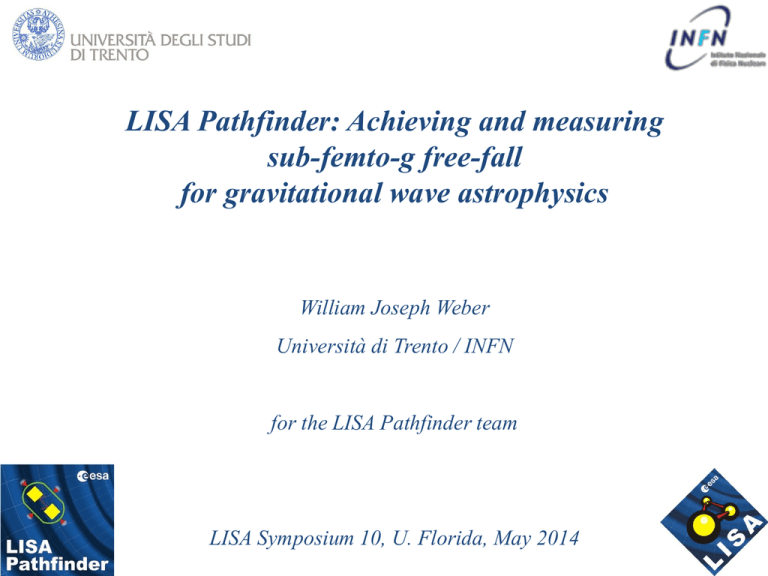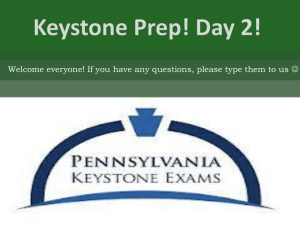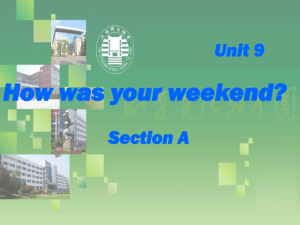LISA Pathfinder: Achieving and measuring sub-femto-g free-fall for gravitational wave astrophysics
advertisement

LISA Pathfinder: Achieving and measuring sub-femto-g free-fall for gravitational wave astrophysics William Joseph Weber Università di Trento / INFN for the LISA Pathfinder team LISA Symposium 10, U. Florida, May 2014 eLISA link as a differential accelerometer (2 TM in distant SC) Difference in stray force per unit mass IFO doppler signal 106 km r e h t h t L / c g r t g e t L / c 2 c LPF as a differential accelerometer (2 TM in 1 SC) g1 g2 c 40 cm 2 g GOCE LPF similar to 1 axis of a geodesy gravity gradiometer Weber – LISA Symp – U Florida – 19 may 2014 Demonstrating eLISA differential accelerometer performance with LPF • Why LPF can improve upon GOCE performance by more than a factor 1000 design, analysis, experiment • How LPF will demonstrate this Weber – LISA Symp – U Florida – 19 may 2014 From pico-g/Hz1/2 to sub-femto-g/Hz1/2: LPF design innovations • 2 TM, 40-50 cm baseline gradiometer in a drag-free spacecraft • pm/Hz1/2 displacment sensitivity GOCE Actuation force noise «accelerometer range» GRS surface force noise LEO mm/s2(Terrestrial) residual atmosphere 300 gm TM 100 mm gaps discharge wire LPF L1 nm/s2 (spacecraft g) 0 for eLISA !! deep space 2 kg TM 3-4 mm gaps no contacts tough caging UV discharge need IFO Talks H. Ward, D. Robertson Weber – LISA Symp – U Florida – 19 may 2014 Gravitational reference sensor (GRS) subsystem TM + surrounding electrostatic sensor / actuator + vacuum + UV discharge + caging • nm/Hz1/2 capacitive position sensing on all axes • < 10 pm/Hz1/2 science signal is IFO • nN actuation forces (mN non-science) • define environment that allows fN/Hz1/2 on TM Designed to be full flight heritage for eLISA See talk Rita Dolesi Weber – LISA Symp – U Florida – 19 may 2014 LISA Pathfinder as a differential accelerometer Newton’s Eqns: IFO Readouts : m x1 F 1 m 1 p x 1 x SC 2 m x2 F 2 m 2 p x 2 x SC 2 F ES g1 o 12 x 2 x 1 n 12 o 1 x 1 x SC n1 o1 TM1 g2 TM2 o12 Drag-free: thrust SC to follow TM1 (null o1, 1 Hz BW) Electrostatic suspension: force TM2 to follow TM1 (null o12, 1 mHz BW) Control IFO Acceleration g F2 m F1 m o12 F ES m 2 p 1 p o 1 2 p o 12 2 2 2 n12 2 p 1 p n 1 2 p n 12 2 2 IFO Noise Elastic Commanded coupling control forces • Produce differential acceleration time series • Spacecraft coupling term (stiffness) subtracted (also for LISA) Weber – LISA Symp – U Florida – 19 may 2014 2 LISA Pathfinder control, displacement and acceleration o1 TM1 TM2 o12 Free particle «measure acceleration» g o12 F ES m 2 p 1 p o 1 2 p o 12 2 2 2 Accelerometer «measure control force» «working in acceleration» • use dynamic parameters but not transfer function • remove long transients Weber – LISA Symp – U Florida – 19 may 2014 Calibrating the LPF differential accelerometer g o12 F ES m o 1 2 p o 12 2 2 o12 Actuator calibration factor o1 Background force + IFO noise FC m o 1 2 p o 12 g g IFO 2 2 dynamical stiffness o12 • Modulate satellite drag-free and electrostatic setpoints • Fit acceleration to commanded force (FC), measured positions o12, o1 + other measured disturbances • Background force (g) and IFO noise See talks Martin Hewitson + Daniel Vetrugno Weber – LISA Symp – U Florida – 19 may 2014 LPF performance and TM acceleration noise sources for eLISA Torsion pendulum small force measurements (lightweight TM) LPF Instrument limit IFO Actuation noise Surface 3D sensing + actuation Bulk LISA Pathfinder flight test Weber – LISA Symp – U Florida – 19 may 2014 GRS surface force noise: overall upper limits with torsion pendulum Tungsten fiber (Q = 3000) • LISA-like TM suspended inside prototype GRS with FEE Fused Silica fiber (Q = 800000) • Attribute ALL unexplained torque noise to interaction between GRS – TM • Convert to equivalent acceleration surface force noise upper limit • Within factor 2 of LPF spec at 1 mHz • Many known forces measured to eLISA goal LPF Spec Torsion pendulum upper limit eLISA Spec Weber – LISA Symp – U Florida – 19 may 2014 LPF instrument limit: noisy compensation of spacecraft self-gravity «accelerometer dynamic range» problem g1 Noise in “DC” force applied to compensate local g g2 Not present in eLISA!! 2 F V ACT Design specs g 0 . 65 nm/s 1/ 2 S V Fx N /V 2 10 -6 1/ 2 Sa 1/ 2 2 g S V /V Current spacecraft mass balance calculations look better! 2 /Hz 1/2 Current measurements 2-3 worse • Expect < 8 fm/s2/Hz1/2 at 1 mHz • full analysis complicated by uncorrelated voltage fluctuations, act Weber – LISA Symp – U Florida – 19 may 2014 Gravitational balancing to g < 1 nm/s2 Opt bench + GRS (TM – TM) ~ -50 nm/s2 ~ -2 nm/s2 Spec Model 0.65 nm/s2 ~ 10 nm/s2 level compensate by GRS internal balancing masses (IBM) 1.8 kg W • No full ground test: analysis (1/r2) + mass + position measurements • In flight: measure 3 trans + 6 rot gravitational balances + measure gravitational stiffnesses Weber – LISA Symp – U Florida – 19 may 2014 LISA Pathfinder performance: with and without x-actuation LPF spec LPF best est • Expect to beat LPF spec at all frequencies • If gravitational balancing at spec level, likely limited by actuation that is not present in eLISA Weber – LISA Symp – U Florida – 19 may 2014 LISA Pathfinder: avoiding actuation fluctuations with free-fall mode compensate average DC force imbalance by applying a large impulse followed by free-fall (parabolic flight!) x 10 mm Grynagier, CQG 26 (2009) 094007 • Example: Apply 100 x average needed force for 2.5 s, followed by 247.5 s free-fall • Analyze only free-fall data, avoid impulses window to avoid gaps (windowed PSD) Iteratively extract noise to fill gaps (standard PSD) Low pass / decimate / detrend, set gap data to 0 (standard PSD) • Can we recover intrinsic force noise at 10-3 -- 10-4 Hz in a series of 250 s experiments? Weber – LISA Symp – U Florida – 19 may 2014 Testing free-fall mode on the ground • Can we recover intrinsic force noise at 10-3 -- 10-4 Hz in a series of 250 s experiments? • Data with gaps (spectral leakage) • Huge increase in dynamic range (displacement and velocity) • Sensing and dynamic non-linearities, timing • What are the conditions in which free-fall / impulse mode can be used? • Force levels, displacement range, time of flight On-ground test: • Rotated torsion pendulum forced to center • Can choose levels of: • DC force (pendulum rotation) • Elastic coupling (applied voltages) • Flight and impulse times Free-fall talks: Ira Thorpe, Giuliana Russano, John Conklin Weber – LISA Symp – U Florida – 19 may 2014 LISA Pathfinder performance prediction LPF best est eLISA TM accel noise spec LISA Pathfinder should guarantee most of LISA science (performance needed to observe calibration binaries with SNR=1 in 1 year) Weber – LISA Symp – U Florida – 19 may 2014 LPF: a physical model of limits to measuring differential acceleration In – orbit and on-ground Example: electrostatics inside GRS • stray electrostatic fields (patch effects) • cosmic ray charging Largest interaction: TM charge + average residual E field [PRL 108:181101 (2012)] q V Fx q E x x 1 C x x 1 q x C TOT i ( TM ), j ( S ) C ij x 1 x gap C x V i V j x : equiv. single electrode potential UV discharge of TM Charge noise requires compensation of average stray field Operation with non-zero q requires low fluctuations in stray field Weber – LISA Symp – U Florida – 19 may 2014 Stray electrostatics (on ground): dN/dq (charge bursts) Measure /compensate dF/dq (dN/dq) dN/dVTM (modulate VTM) • Measure / compensate 100 mV < 1 mV • Need to measure dF/dq by varying charge (not with modulated VTM) Uncompensated Compensated Measure noise in dF/dq (dN/dq) • Torque noise with charged TM S 1/ 2 80 m V/Hz 1/2 at 1 mHz x • Single electrode (500 mm2) < 12 mV/Hz1/2 • OK for eLISA (marginally) Tests of UV discharge, charge measurement Weber – LISA Symp – U Florida – 19 may 2014 Stray electrostatics (In-flight): Measure compensate dF/dq with UV TM charge bursts and modulated voltages • Performance and debugging LPF simulator • Several times and for two TM Measure long-term TM charge fluctuations • How well / how often do we need to balance field? • Confirm charging models, low freq noise x = 27.4 +/- 0.5 mV (c2 =5.4 , 17 DOF) • Correlation with radiation monitor Full UV discharge testing • Fast discharge and continuous See talk Valerio Ferroni If necessary ... • force noise with charged TM • effect of single (bad) electrode Weber – LISA Symp – U Florida – 19 may 2014 Measurement science investigations with LPF • Measure spacecraft g (3 translations and 6 rotations) • Force noise from actuation (free-fall mode) • Measure temperature fluctuations down to 10-4 Hz – and below – and dF/dT Talk Ferran Gibert • Measure magnetic environment and forces from applied B fields Talk Miquel Nofrarias • Measurement and compensation of average stray E field (nulling dF/dq) • Measure low frequency charge fluctuations with long term charge test Talk Valerio Ferroni • Stiffness / SC coupling / crosstalk measurements Talk Daniel Vetrugno Create physical model for limits to achieving perfect free-fall Weber – LISA Symp – U Florida – 19 may 2014 Thank you! and thanks to the LPF team ... see you in summer 2015! Weber – LISA Symp – U Florida – 19 may 2014






